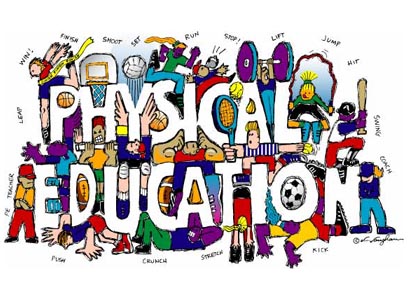Physical education is a vital part of the total education of every child from kindergarten through grade 12.
Quality physical education programs are needed to increase the physical competence, health-related fitness, self-responsibility, and enjoyment of physical activity for all students so that they can be physically active for a lifetime. Physical education programs can only provide these benefits if they are well-planned and well-implemented.
Why do children need physical education?
- Improved Physical Fitness
Improves children’s muscular strength, flexibility, muscular endurance, body composition and cardiovascular endurance - Skill Development
Develops motor skills, which allow for safe, successful and satisfying participation in physical activities - Regular, Healthful Physical Activity
Provides a wide-range of developmentally appropriate activities for all children - Support of Other Subject Areas
Reinforces knowledge learned across the curriculum. Serves as a lab for application of content in science, math and social studies. - Self-Discipline
Facilitates development of student responsibility for health and fitness - Improved Judgment
It can affect moral development. Students have the opportunity to assume leadership, cooperate with others; question actions and regulations and accept responsibility for their own behavior. - Stress Reduction
Physical activity becomes an outlet for releasing tension and anxiety, and facilitates emotional stability and resilience. - Strengthened Peer Relationships
It can be a major force in helping children socialize with others successfully and provides opportunities to learn positive people skills. Especially during late childhood and adolescence, being able to participate in dances, games and sports is an important part of peer culture. - Improved Self-Confidence and Self-Esteem
It instills a stronger sense of self-worth in children based on their mastery of skills and concepts in physical activity. They can become more confident, assertive, independent and self-controlled. - Experience Setting Goals
Gives children the opportunity to set and strive for personal, achievable goals
Quality Physical Education
Why is quality physical education important? Quality physical education programs help all students develop health-related fitness, physical competence, cognitive understanding, and positive attitudes about physical activity, so that they can adopt healthy and physically active lifestyles.
Quality physical education programs provide learning experiences that improve mental alertness, academic performance, and readiness and enthusiasm for learning in our nations’ youth.
Key Points
1. Opportunity to Learn
* All students are required to take physical education
* Instructional periods totaling 150 minutes per week (elementary) and 225 minutes per week (middle and secondary school)
* Physical education class size consistent with that of other subject areas
* Qualified physical education specialist provides a developmentally appropriate program
* Adequate equipment and facilities
- Meaningful Content
* Written, sequential curriculum for grades P-12, based on state and/or national standards
* Instruction in a variety of motor skills designed to enhance the physical, mental, and social/emotional development of every child
* Fitness education and assessment to help children understand, improve and/or maintain physical well-being
* Development of cognitive concepts about motor skill and fitness
* Opportunities to improve emerging social and cooperative skills and gain a multi-cultural perspective
* Promotion of regular amounts of appropriate physical activity now and throughout life - Appropriate Instruction
* Full inclusion of all students
* Maximum practice opportunities for class activities
* Well-designed lessons that facilitate student learning
* Out of school assignments that support learning and practice
* Physical activity not assigned as or withheld as punishment
* Regular assessment to monitor and reinforce student learning - Student and Program Assessment
* Assessment is an ongoing, vital part of the P.E. program
* Formative and summative assessment of student progress
* Student assessments aligned with state/national physical education standards and the written physical education curriculum
* Assessment of program elements that support quality physical education
* Stakeholders periodically evaluate the total physical education program effectiveness
